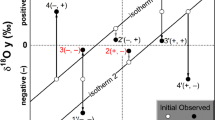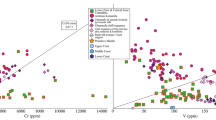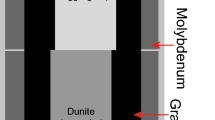Abstract
Yucca Mountain, Nevada, is being investigated to determine its suitability to host a potential high-level radioactive waste respository. An important reason for its choice as a potential repository site was the presence of thick zeolite-rich horizons in the altered volcanic tufts that compose the mountain. Clinoptilolite is the most abundant zeolite at Yucca Mountain and may be important in radionuclide retardation and in determining hydrologic properties. Therefore, it is necessary to understand the geochemical conditions affecting its long-term stability. For example, it has been suggested that long-term, repository-induced heating of the rocks at Yucca Mountain may lead to the transformation of clinoptilolite to analcime, thereby significantly affecting the hydrologic properties and retardation capabilities of the rock.
Thermodynamic modeling of clinoptilolite-analcime equilibria was conducted with the program Ge0-Calc PTA-SYSTEM using estimated thermodynamic data for measured chemical compositions of clinoptilolite and analcime at Yucca Mountain. Log[aK+)2/aCa2+] versus log[aNa+)2/aCa2+] diagrams were calculated to model the conditions under which clinoptilolite may transform to analcime. Temperature, relative cation abundances and silica activity are all important factors in determining clinoptilolite-analcime equilibria. Increased Na+ concentrations in either clinoptilolite or the fluid phase, increased clinoptilolite K+ concentration, increased temperature and decreased aqueous silica activity all stabilize analcime relative to clinoptilolite, assuming present-day Yucca Mountain water compositions. However, increased Ca2+ concentrations in either clinoptilolite or the fluid phase, increased aqueous K+ concentration and increased Al:Si ratios in clinoptilolite (heulandite) all stabilize clinoptilolite with respect to analcime.
Assuming well J-13 water as the analog chemistry for Yucca Mountain water, clinoptilolite should remain stable with respect to analcime if temperatures in the clinoptilolite-bearing horizons do not significantly exceed 100 °C. Even if temperatures rise significantly (for example, to 150 °C not all clinoptilolite should alter to analcime. Perhaps more importantly, thermodynamic modeling suggests that some Yucca Mountain clinoptilolites, particularly those rich in Ca and Al, will remain stable at elevated temperatures, even with an aqueous silica activity at quartz saturation.
Similar content being viewed by others
References
Ames LL Jr. 1964a. Some zeolite equilibria with alkali metal cations. Am Mineral 49:127–145.
Ames LL Jr. 1964b. Some zeolite equilibria with alkaline earth metal cations. Am Mineral 49:1099–1110.
Barrer RM, Klinowski J. 1974. Ion-exchange selectivity and electrolyte concentration. J Chem Soc Faraday Trans 70: 2080–2091.
Berman RG. 1988. Internally consistent thermodynamic data for minerals in the system Na2O-K2O-CaO-MgO-FeO-Fe2O3-Al2O3-SiO2-TiO2-H2O-CO2. J Petrol 29:445–522.
Berman RG, Brown TH. 1985. Heat capacity of minerals in the system Na2O-K2O-CaO-MgO-FeO-Fe2O3-Al2O3-SiO2-TiO2-H2O-CO2: Representation, estimation, and high temperature extrapolation. Contrib Mineral Petrol 89:168–183.
Bish DL. 1988. Effects of composition on the dehydration behavior of clinoptilolite and heulandite. In: Kallo D, Sherry HS, editors. Occurrence, properties and utilization of natural zeolites. Budapest: Akademiai Kiado. p 565–576.
Bish DL. 1989. Evaluation of past and future alterations in tuff at Yucca Mountain, Nevada, based on the clay mineralogy of drill cores USW G-l, G-2, and G- 3. Los Alamos National Laboratory Report LA-10667-MS. 40 p.
Bish DL. 1990. Long-term thermal stability of clinoptilolite: The development of a “B” phase. Eur J Mineral 2:771–777.
Bish DL, Aronson JL. 1993. Paleogeothermal and paleohy-drologic conditions in silicic tuff from Yucca Mountain, Nevada. Clays Clay Miner 41:148–161.
Bish DL, Chipera SJ. 1989. Revised mineralogic summary of Yucca Mountain, Nevada. Los Alamos National Laboratory Report LA-11497-MS. 68 p.
Boles JR. 1971. Synthesis of analcime from natural heulandite and clinoptilolite. Am Mineral 56:1724–1734.
Bowers TS, Burns RG. 1990. Activity diagrams for clinoptilolite: Susceptibility of this zeolite to further diagenetic reactions. Am Mineral 75:601–619.
Brown TH, Berman RG, Perkins EH. 1989. PTA-SYSTEM: A GeO-Calc software package for the calculation and display of activity-temperature-pressure phase diagrams. Am Mineral 74:485–487.
Broxton DE, Bish DL, Warren RG. 1987. Distribution and chemistry of diagenetic minerals at Yucca Mountain, Nye County, Nevada. Clays Clay Miner 35:89–110.
Broxton DE, Warren RG, Hagan RC, Luedemann G. 1986. Chemistry of diagenetically altered tuffs at a potential nu-clear waste repository, Yucca Mountain, Nye County, Nevada. Los Alamos National Laboratory Report LA-10802-MS. 160 p.
Bruton C, Glassley WE, Viani BE. 1993. Geochemistry. In: Wilder DG, editor. Preliminary near-field environment report, volume II: Scientific overview of near-field environment and phenomena. Lawrence Livermore National Laboratory Report UCRL-LR-107476 vol 2. 37: 122.
Buscheck TA, Nitao JJ, Saterlie SF. 1994. Evaluation of ther-mo-hydrological performance in support of the thermal loading systems study. High Level Radioactive Waste Management, Proc 5th Annu Int Conf, vol 2; 22–26 May 1994; Las Vegas, NV. p 592–610.
Carey JW, Bish DL. 1996. Equilibrium in the clinoptilolite-H2O system. Am Mineral 81:952–962.
Chermak JA, Rimstidt JD. 1989. Estimating the thermodynamic properties (ΔAGìno and ΔHto) of silicate minerals at 298 K from the sum of polyhedral contributions. Am Mineral 74:1023–1031.
Chipera SJ, Bish DL. 1988. Mineralogy of drill hole UE-25p#l at Yucca Mountain, Nevada. Los Alamos National Laboratory Report LA-11292-MS. 24 p.
Chipera SJ, Bish DL, Carlos BA. 1995. Equilibrium mod-eling of the formation of zeolites in fractures at Yucca Mountain, Nevada. In: Ming DW, Mumpton FA, editors. Natural zeolites ’93: Occurrence, properties, use. Broekport, NY: Int Committee on Natural Zeolites. p 565–577.
Codell RB, Murphy WM. 1992. Geochemical model for 14C transport in unsaturated rock. Proc 3rd Annu High Level Radioactive Waste Management Meeting; Las Vegas, NV. 1959–1965.
Delany JM. 1985. Reactions of Topopah Spring Tuff with J-13 water: A geochemical modeling approach using the EQ3/6 reaction path code. Lawrence Livermore National Laboratory Report UCRL- 53631. 46 p.
Duffy CJ. 1993a. Preliminary conceptual model for mineral evolution in Yucca Mountain. Los Alamos National Laboratory Report LA-12708-MS. 46 p.
Duffy CJ. 1993b. Kinetics of silica-phase transitions. Los Alamos National Laboratory Report LA-12564-MS. 22 p.
Gottardi G, Galli E. 1985. Natural zeolites. New York: Springer-Verlag. 409 p.
Hay RL. 1966. Zeolites and zeolitic reactions in sedimentary rocks. Geol Soc Am Spec Pap 85. 130 p.
Hay RL. 1978. Geologie occurrence of zeolites. In: Sand LB, Mumpton FA, editors. Natural zeolites: Occurrence, properties, use. New York: Pergamon Pr. p 135–143.
Hazen RM. 1985. Comparative crystal chemistry and the polyhedral approach. In: Kieffer SW, Navrotsky A, editors. Microscopic to macroscopic: Atomic environments to mineral thermodynamics. Rev Mineral 14. Washington DC: Mineral Soc Am. p 317–345.
Helgeson HC, Kirkham DH, Flowers GC. 1981. Theoretical prediction of the thermodynamic behavior of aqueous elec-trolytes at high pressures and temperatures: IV. Calculation of activity coefficients, osmotic coefficients, and apparent molal and Standard and relative partial molal properties to 600°C and 5kb. Am J Sci 281:1249–1516.
Hemingway BS, Robie RA. 1984. Thermodynamic properties of zeolites: Low-temperature heat capacities and thermodynamic functions for phillipsite and clinoptilolite. Estimates of the thermochemical properties of zeolitic water at low temperature. Am Mineral 69:692–700.
Holland TJB. 1989. Dependence of entropy on volume for silicate and oxide minerals: A review and a predictive model. Am Mineral 74:5–13.
Honda A, Muffier LJP. 1970. Hydrotriermal alteration in core from research drill hole Y-l, Upper Geyser Basin, Yellow-stone National Park, Wyoming. Am Mineral 55:1714–1737.
Howell DA, Johnson GK, Tasker IR, O’Hare PAG, Wise WS. 1990. Thermodynamic properties of the zeolite stilbite. Zeolites 10:525–531.
Iijima A. 1975. Effect of pore water to clinoptilolite-analcime-albite reaction series. J Fac Sci, Univ Tokyo, Sec II 19:133–147.
Iijima A. 1978. Geologie occurrences of zeolites in marine environments. In: Sand LB, Mumpton FA, editors. Natural zeolites: Occurrence, properties, use. New York: Pergamon Pr. p 175–198.
Johnson GK, Flotow HE, O’Hare PAG, Wise WS. 1982. Thermodynamic studies of zeolites: Analcime and dehy-drated analcime. Am Mineral 67:736–748.
Johnson GK, Flotow HE, O’Hare PAG, Wise WS. 1985. Thermodynamic studies of zeolites: ai]Heulandite. Am Mineral 70:1065–1071.
Johnson GK, Tasker IR, Jurgens R, O’Hare PAG. 1991. Thermodynamic studies of zeolites: Clinoptilolite. J Chem Thermodynamics 23:475–484.
Johnson GK, Tasker IR, Flotow HE, O’Hare PAG, Wise WS. 1992. Thermodynamic studies of mordenite, dehydrated mordenite, and gibbsite. Am Mineral 77:85–93.
Johnson JW, Oelkers EH, Helgeson HC. 1991. SUPCRT92: A software package for calculating the Standard molal thermodynamic properties of minerals, gases, aqueous species, and reaction from 1 to 5000 bars and 0° to 1000°C: Earth Sciences Dept, L-219, Lawrence Livermore National Lab-oratory, Livermore, CA. 80 p.
Johnstone JK, Peters RR, Gnirk PE 1984. Unit evaluation at Yucca Mountain, Nevada Test Site: Summary report and recommendations. Sandia National Laboratory Report SAND83-0372.
Jones BF, Rettig SL, Eugster HP. 1967. Silica in alkaline brines. Science 158:1310–1314.
Keith TEC, White DE, Beeson MH. 1978. Hydrothermal al-teration and self-sealing in Y-7 and Y-8 in northern part of Upper Geyser Basin, Yellowstone National Park, Wyoming. USGS Prof Paper 1054-A. 26 p.
Kerrisk JE 1983. Reaction-path calculations of groundwater chemistry and mineral formation at Rainier Mesa, Nevada. Los Alamos National Laboratory Report LA-9912-MS. 41 p.
Kerrisk JE 1987. Groundwater chemistry at Yucca Mountain, Nevada, and vicinity. Los Alamos National Laboratory Report LA-10929-MS. 118 p.
Knauss KG, Beiriger WJ, Peifer DW. 1985. Hydrothermal interaction of crushed Topopah Spring Tuff and J-13 water at 90, 150, and 250°C using Dickson-type, gold-bag rocking autoclaves. Lawrence Livermore National Laboratory Report UCRL- 53630. 27 p.
Knauss KG, Beiriger WJ, Peifer DW. 1987. Hydrothermal interaction of solid wafers of Topopah Spring Tuff with J-13 water at 90 and 150°C using Dickson-type, gold-bag rocking autoclaves: Long-term experiments. Lawrence Livermore National Laboratory Report UCRL- 53722. 21 p.
Knauss KG, Beiriger WJ, Peifer DW, Piwinskii AJ. 1985. Hydrothermal interaction of solid wafers of Topopah Spring Tuff with J-13 and distilled water at 90, 150, and 250°C, using Dickson-type, gold-bag rocking autoclaves. Lawrence Livermore National Laboratory Report UCRL- 53645. 55 p.
Knauss KG, Peifer DW. 1986. Reaction of vitric Topopah Spring Tuff and J-13 ground water under hydrothermal conditions using Dickson-type, gold-bag rocking autoclaves. Lawrence Livermore National Laboratory Report UCRL- 53795. 39 p.
Mumpton FA. 1960. Clinoptilolite redefined. Am Mineral 45:351–369.
Murphy WM. 1994. Geochemical models for gas-water-rock interactions in a proposed nuclear waste repository at Yucca Mountain, Nevada. Proc Site Characterization and Model Validation Focus 93: American Nuclear Society, p 115–121.
Murphy WM, Pabalan RT. 1994. Geochemical investigations related to the Yucca Mountain environment and potential nuclear waste repository. US Nuclear Regulatory Commission Report NUREG/CR- 6288. 190 p.
Pabalan RT, Bertetti FP. 1994. Thermodynamics of ion-ex-change between Na+/Sr2+ solutions and the zeolite mineral clinoptilolite. Mat Res Soc Symp Proc 333:731–738.
Pabalan RT, Murphy WM. 1990. Progress in experimental studies on the thermodynamic and ion exchange properties of clinoptilolite. Center for Nuclear Waste Regulatory Analyses, CNWRA 89-006, San Antonio, TX. 39 p.
Perry E, Hower J. 1970. Burial diagenesis in Gulf Coast pelitic sediments. Clays Clay Miner 18:165–177.
Perfect DL, Faunt CC, Steinkampf WC, Turner AK. 1995. Hydrochemical data base for the Death Valley Region, California and Nevada. USGS Open File Report 94-305. 10 p.
Robinson GR Jr, Haas JL Jr. 1983. Heat capacity, relative enthalpy, and calorimetric entropy of silicate minerals: An empirical method of prediction. Am Mineral 68:541–553.
Sheppard RA, Gude AJ 3rd. 1968. Distribution and genesis of authigenic silicate minerals in tuffs of Pleistocene Lake Tecopa, Inyo County, California. USGS Prof Pap 597. 38 p.
Sheppard RA, Gude AJ 3rd. 1969. Diagenesis of tuffs in the Barstow Formation, Mud Hills, San Bernardino County, California. USGS Prof Pap 634. 35 p.
Sheppard RA, Gude AJ 3rd. 1973. Zeolites and associated authigenic silicate minerals in tuffaceous rocks of the Big Sandy Formation, Mohave County, Arizona. USGS Prof Pap 830. 36 p.
Smyth JR. 1982. Zeolite stability constraints on radioactive waste isolation in zeolite-bearing volcanic rocks. J Geol 90: 195–202.
Smyth JR, Caporuscio FA. 1981. Review of the thermal stability and cation exchange properties of the zeolite minerals clinoptilolite, mordenite, and analcime: Applications to radioactive waste isolation in silicic tuff. Los Alamos National Laboratory Report LA-8841-MS. 30 p.
Surdam RC, Sheppard RA. 1978. Zeolites in saline, alkaline-lake deposits. In: Sand LB, Mumpton FA, editors. Natural zeolites: Occurrence, properties, use. New York: Pergamon Pr. p 145–174.
Vaughan DEW. 1978. Properties of natural zeolites. In: Sand LB, Mumpton FA, editors. Natural zeolites: Occurrence, properties, use. New York: Pergamon Pr. p 353–371.
White AF, Claassen HC, Benson LV. 1980. The effect of dissolution of volcanic glass on the water chemistry in a tuffaceous aquifer, Rainier Mesa, Nevada. USGS Geol Sur-vey Water-Supply Pap 1535-Q. 34 p.
Wilkin RT, Barnes HL. 1995. Solubilities of the zeolites analcime and Na-clinoptilolite in hydrothermal solutions. In: Barnes HL, editor. V. M. Goldschmidt Conf, Program and Abstracts. 97 p.
Yang IC. 1992. Flow and transport through unsaturated rock—data from two test holes, Yucca Mountain, Nevada. Proc 3rd Annu High Level Radioactive Waste Management Meeting; Las Vegas, NV. p 732–737.
Author information
Authors and Affiliations
Rights and permissions
About this article
Cite this article
Chipera, S.J., Bish, D.L. Equilibrium Modeling of Clinoptilolite-Analcime Equilibria at Yucca Mountain, Nevada, USA. Clays Clay Miner. 45, 226–239 (1997). https://doi.org/10.1346/CCMN.1997.0450211
Received:
Accepted:
Published:
Issue Date:
DOI: https://doi.org/10.1346/CCMN.1997.0450211




